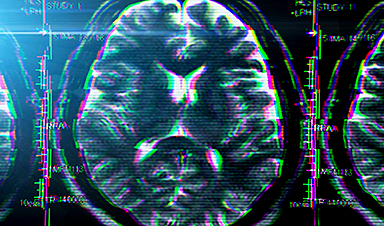Research from the University of Washington revealed that COVID-19 lockdowns led to accelerated cortical thinning in adolescents, impacting brain development significantly.
This effect was more pronounced in females than males, raising concerns about long-term brain health. The study highlights the importance of social interactions during adolescence, a period critical for cognitive development and mental health, especially as social restrictions have exacerbated conditions like anxiety and depression among teenagers.
Impact of Lockdowns on Adolescent Brain Development
A recent study reported the somewhat alarming findings that the social disruptions of COVID-19 lockdowns caused significant changes in teenagers' brains.
Researchers at the University of Washington in Seattle used MRI scans to examine the adolescent brain's cortex — the folded outer layer responsible for complex thinking. They discovered that the typical age-related thinning of the cortex accelerated after the lockdowns, with girls showing more pronounced changes than boys.
What do these findings mean?
Science highlights adolescence as a critical stage for brain development. Many typical teenage behaviors stem from the brain cortex still maturing. During this period, key developmental processes occur, including the thinning of the cortex, which helps the brain become more efficient and better organized.
Groundbreaking research published in 2022 provided the first evidence of a crucial window of brain "plasticity" — its ability to adapt — in the frontal brain region. This area is essential for functions such as decision-making, problem-solving, short-term memory, and managing social behavior.

Given the evidence of this sensitivity of brain development in adolescence, is it possible that the pandemic lockdowns really did accelerate harmful brain aging in teenagers? And how strong is the evidence that it was due to the lockdowns and not something else?
To answer the first question, we have to realize that aging and development are two sides of the same coin. They are inextricably linked. On the one hand, biological aging is the progressive decline in the function of the body's cells, tissues, and systems. On the other, development is the process by which we reach maturity.
Adverse conditions at critical periods of our life, especially adolescence, are very likely to influence our aging trajectory. It is therefore plausible that the "accelerated maturation" of the teenage brain cortex is an age-related change that will affect the rate of brain aging throughout life.
So it seems there is an unpalatable and much more serious conclusion: the reported accelerated maturation – though serious enough – is not a one-off detriment. It may well set a trajectory of adverse brain aging way beyond adolescence.
The Role of Social Interaction in Brain Health
Now to the second question: the role, if any, of the lockdowns. One of the central pillars of brain health is "social cognition": the capacity of the brain to interact socially with others. It has been embedded in our brains for 1.5 million years. It is not an optional add-on. It is fundamentally important. Interfere with it and potentially devastating health consequences result, particularly in adolescents who depend on social interaction for normal cognitive development.
At the same time, adolescence is also a period of the emergence of many neuropsychiatric disorders, including anxiety and depression, with younger females at a higher risk of developing anxiety and mood disorders than males.
Devastating Consequences
The socially restrictive lockdown measures appear to have had a substantial negative effect on the mental health of teenagers, especially girls, and the new study provides a potential underlying cause.
There is little doubt that the pandemic lockdowns resulted in devastating health consequences for many people. To the litany of evidence, we may now add a particularly grim finding – that the developmental brain biology of our precious teenage population has been damaged by these measures.
But perhaps the main message is that the wider effects of single-issue health policies should be considered more carefully. In the case of the known damaging effects of social isolation and loneliness on brain health, it's not as if the evidence wasn't there.
Written by James Goodwin, Professor in the Physiology of Ageing, Loughborough University.
Adapted from an article originally published in The Conversation.
Reference: "COVID-19 lockdown effects on adolescent brain structure suggest accelerated maturation that is more pronounced in females than in males" by Neva M. Corrigan, Ariel Rokem and Patricia K. Kuhl, 9 September 2024, Proceedings of the National Academy of Sciences.
DOI: 10.1073/pnas.2403200121
News
Mystery Solved: Scientists Find Cause for Unexplained, Deadly Diseases
A study reveals that a protein called RPA is essential for maintaining chromosome stability by stimulating telomerase. New findings from the University of Wisconsin-Madison suggest that problems with a key protein that helps preserve chromosome stability [...]
Nanotech Blocks Infection and Speed Up Chronic Wound Recovery
A new nanotech-based formulation using quercetin and omega-3 fatty acids shows promise in halting bacterial biofilms and boosting skin cell repair. Scientists have developed a nanotechnology-based treatment to fight bacterial biofilms in wound infections. The [...]
Researchers propose five key questions for effective adoption of AI in clinical practice
While Artificial Intelligence (AI) can be a powerful tool that physicians can use to help diagnose their patients and has great potential to improve accuracy, efficiency and patient safety, it has its drawbacks. It [...]
Advancements and clinical translation of intelligent nanodrugs for breast cancer treatment
A comprehensive review in "Biofunct. Mater." meticulously details the most recent advancements and clinical translation of intelligent nanodrugs for breast cancer treatment. This paper presents an exhaustive overview of subtype-specific nanostrategies, the clinical benefits [...]
It’s Not “All in Your Head”: Scientists Develop Revolutionary Blood Test for Chronic Fatigue Syndrome
A 96% accurate blood test for ME/CFS could transform diagnosis and pave the way for future long COVID detection. Researchers from the University of East Anglia and Oxford Biodynamics have created a highly accurate [...]
How Far Can the Body Go? Scientists Find the Ultimate Limit of Human Endurance
Even the most elite endurance athletes can’t outrun biology. A new study finds that humans hit a metabolic ceiling at about 2.5 times their resting energy burn. When ultra-runners take on races that last [...]
World’s Rivers “Overdosing” on Human Antibiotics, Study Finds
Researchers estimate that approximately 8,500 tons of antibiotics enter river systems each year after passing through the human body and wastewater treatment processes. Rivers spanning millions of kilometers across the globe are contaminated with [...]
Yale Scientists Solve a Century-Old Brain Wave Mystery
Yale scientists traced gamma brain waves to thalamus-cortex interactions. The discovery could reveal how brain rhythms shape perception and disease. For more than a century, scientists have observed rhythmic waves of synchronized neuronal activity [...]
Can introducing peanuts early prevent allergies? Real-world data confirms it helps
New evidence from a large U.S. primary care network shows that early peanut introduction, endorsed in 2015 and 2017 guidelines, was followed by a marked decline in clinician-diagnosed peanut and overall food allergies among [...]
Nanoparticle blueprints reveal path to smarter medicines
Lipid nanoparticles (LNPs) are the delivery vehicles of modern medicine, carrying cancer drugs, gene therapies and vaccines into cells. Until recently, many scientists assumed that all LNPs followed more or less the same blueprint, [...]
How nanomedicine and AI are teaming up to tackle neurodegenerative diseases
When I first realized the scale of the challenge posed by neurodegenerative diseases, such as Alzheimer's, Parkinson's disease and amyotrophic lateral sclerosis (ALS), I felt simultaneously humbled and motivated. These disorders are not caused [...]
Self-Organizing Light Could Transform Computing and Communications
USC engineers have demonstrated a new kind of optical device that lets light organize its own route using the principles of thermodynamics. Instead of relying on switches or digital control, the light finds its own [...]
Groundbreaking New Way of Measuring Blood Pressure Could Save Thousands of Lives
A new method that improves the accuracy of interpreting blood pressure measurements taken at the ankle could be vital for individuals who are unable to have their blood pressure measured on the arm. A newly developed [...]
Scientist tackles key roadblock for AI in drug discovery
The drug development pipeline is a costly and lengthy process. Identifying high-quality "hit" compounds—those with high potency, selectivity, and favorable metabolic properties—at the earliest stages is important for reducing cost and accelerating the path [...]
Nanoplastics with environmental coatings can sneak past the skin’s defenses
Plastic is ubiquitous in the modern world, and it's notorious for taking a long time to completely break down in the environment - if it ever does. But even without breaking down completely, plastic [...]
Chernobyl scientists discover black fungus feeding on deadly radiation
It looks pretty sinister, but it might actually be incredibly helpful When reactor number four in Chernobyl exploded, it triggered the worst nuclear disaster in history, one which the surrounding area still has not [...]





















